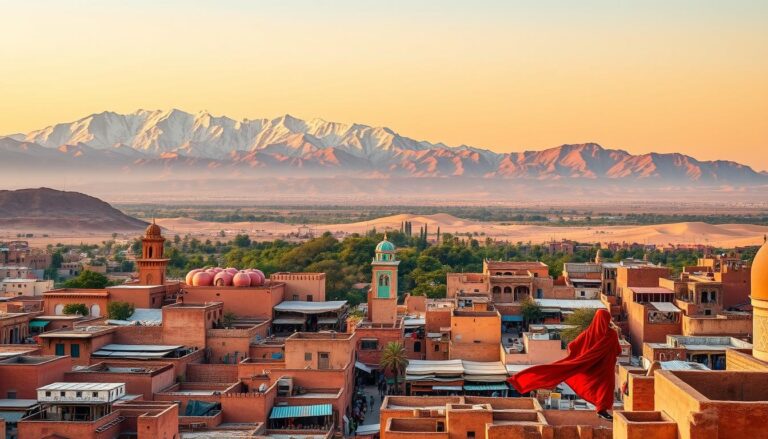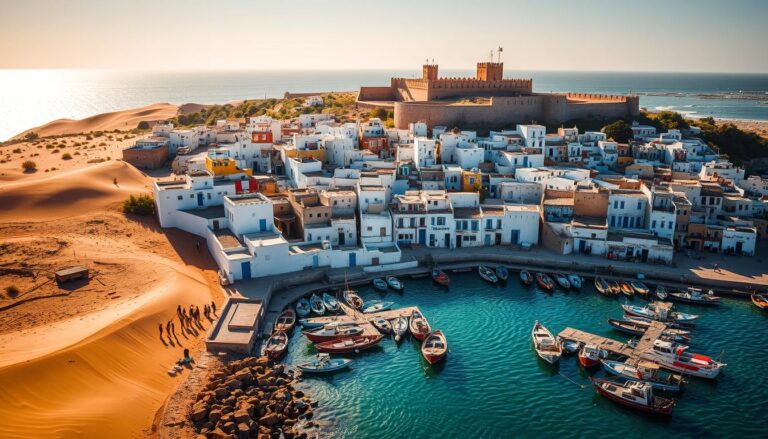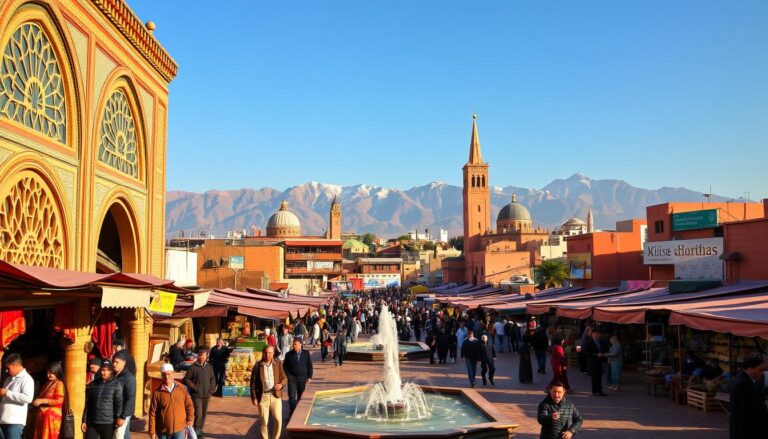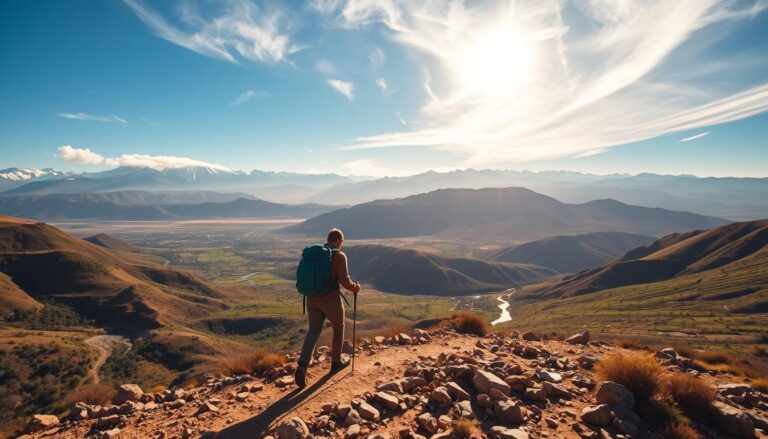FEZ, Morocco: Uncover the Beauty of This Historic City
Table of Contents
Imagine stepping into a living museum where over 1.25 million people maintain traditions unchanged for centuries. This isn’t a fantasy—it’s everyday life in Morocco’s oldest imperial city, where ancient crafts and modern energy collide under the North African sun.
Nestled between the Atlas Mountains and rolling hills, this UNESCO World Heritage Site has been called the “Athens of Africa” for its intellectual legacy. Its labyrinthine medina—the world’s largest car-free urban zone—boasts 9,400 alleys filled with the scent of saffron and the clatter of copper workshops.
You’ll discover why this cultural powerhouse became Morocco’s spiritual heart. From 14th-century madrasas adorned with geometric marvels to communal bakeries using recipes from 859 AD, every corner whispers stories of dynasties past. The Fez River still threads through the old town like a liquid timeline, connecting medieval tanneries with contemporary art galleries.
Key Takeaways
- Home to the world’s largest car-free medieval medina
- Recognized as Morocco’s spiritual and cultural capital
- Features over 9,000 historic alleyways to explore
- Boasts culinary traditions dating back 12 centuries
- Contains hidden architectural gems from multiple empires
Introduction: Your Ultimate Guide to Discovering FEZ, Morocco
Uncover a city divided into three unique worlds. The Moroccan gem blends medieval marvels with colonial charm through its distinct districts: Fes el-Bali (Old Medina), Fes Jdid (New Medina), and Ville Nouvelle. Each quarter tells a different chapter of the city’s 12-century story.
Fes el-Bali’s maze-like streets hide living history – leather tanneries using 11th-century methods and family-run pottery workshops. Fes Jdid offers royal grandeur with its 13th-century palace gates and historic Jewish quarter. Ville Nouvelle surprises with Parisian-style boulevards lined with palm trees and modern cafés.
“Getting lost here isn’t a mistake – it’s how you find the real Fez”
| District | Vibe | Must-See | Tip |
|---|---|---|---|
| Fes el-Bali | Medieval chaos | Chouara Tannery | Wear closed-toe shoes |
| Fes Jdid | Royal elegance | Royal Palace Gates | Visit at golden hour |
| Ville Nouvelle | Modern comfort | Mohammed V Avenue | Try French-Moroccan pastries |
Morning exploration beats crowds in the medinas. Evenings shine in Ville Nouvelle’s cafés. Locals recommend hiring a certified guide for your first medina visit – they’ll help decode hidden symbols on ancient doors.
This ancient land rewards curious travelers. You’ll taste bread baked in communal ovens and hear call-to-prayer echoes bounce between centuries-old walls. The town’s magic lies in its layered history – Roman ruins beneath Andalusian arches, French art deco beside Moorish mosaics.
The Historical Legacy of FEZ and Its Medina
Unearth the stories of a city that once rivaled the world’s greatest capitals. What began as rival riverbank settlements in the late 8th century grew into North Africa’s intellectual heartbeat. You’re standing where scholars mapped stars and poets shaped empires.
Founding and Evolution Through the Centuries
Idris I planted Fez’s first seeds in 789 AD, creating Madinat Fas. His son Idris II expanded across the river 20 years later. By 818, thousands of Andalusian refugees arrived, bringing new crafts and ideas.
| Era | Development | Legacy |
|---|---|---|
| Idrisid Dynasty | Twin settlements merge | Islamic learning hub |
| 12th Century | Population hits 200,000 | World’s largest medina |
| Modern Era | UNESCO protection | Living museum status |
UNESCO World Heritage and Cultural Significance
Why does this maze of 9,400 alleys matter globally? The medina preserves 12 centuries of urban planning. Its tanneries still use stone vats from 1100s, while Quranic schools glow with cedar carvings.
As Morocco’s former capital, Fez attracted:
- Master tile artisans from Spain
- Sufi philosophers from Mali
- Jewish silversmiths from Italy
UNESCO didn’t just protect buildings – they safeguarded a way of life. Your footsteps echo through the world’s largest car-free medieval zone, where history lives in every arched doorway and spice stall.
Architecture and Urban Landscapes in FEZ
Discover a living tapestry where stone whispers stories of empires. The city’s skyline blends Moorish curves with Moroccan practicality, creating spaces that breathe history through every archway and tile. Your eyes will dance across honey-colored walls that have guarded secrets since 1204.

Moorish Mastery Meets Local Craft
Muhammad al-Nasir’s defensive walls still hug the medina like a protective embrace. These 13th-century barriers showcase:
- Rammed earth techniques lasting 800+ years
- Strategic arrow slit placements
- Decorative brickwork patterns
Inside the walls, homes hide andalusí courtyards with zellige tilework. Look up – carved cedar ceilings reveal stars used as ventilation systems.
Palaces That Define Royal Grandeur
The royal palace in Fes Jdid stuns with its golden gates. Though closed to visitors, its exterior tells tales:
| Feature | Dynasty | Hidden Meaning |
|---|---|---|
| Brass doors | Alaouite | Symbolize strength |
| Mosaic courtyard | Marinid | Represents unity |
| Herb gardens | Saadian | Healing traditions |
“Fez’s architecture isn’t decoration – it’s philosophy in physical form”
Wander Ville Nouvelle’s boulevards to see French colonial flair meeting Moroccan motifs. The city’s layers unfold like a pop-up history book – medieval ramparts beside art deco cafes, all united by terracotta hues.
Unraveling the Ancient Medina
Step into a timeless maze where sunlight filters through latticework onto cobblestones worn smooth by 12 centuries of footsteps. This living medieval city thrives as North Africa’s best-preserved car-free zone, its heartbeat pulsing through 9,400 alleys that twist like desert roots.
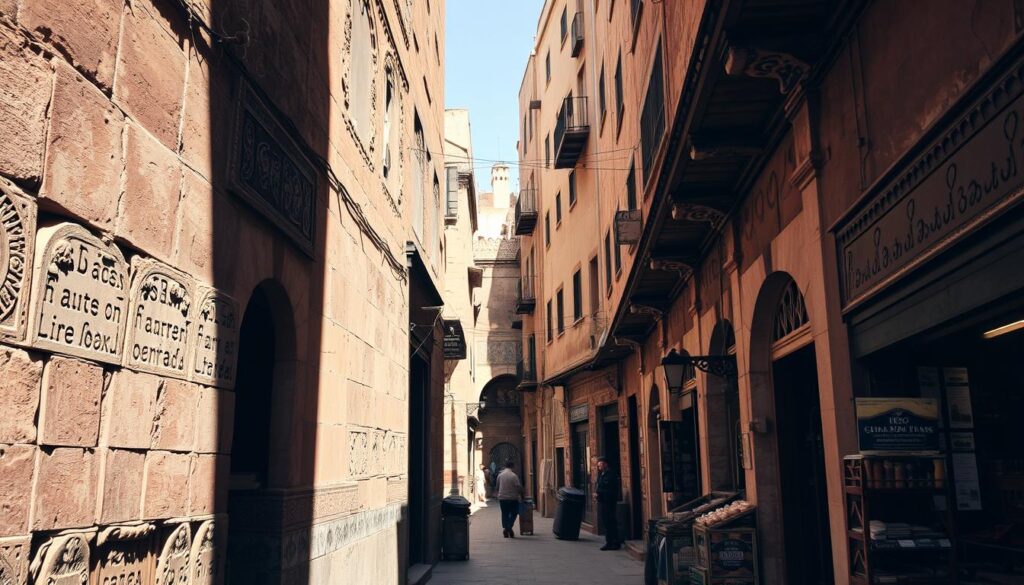
Navigating the Labyrinth of Fes el-Bali
Your sandals will crunch over pebbles as you duck beneath arched passageways barely wider than your shoulders. Locals navigate using three secret codes:
- Carved door knockers marking artisan guilds
- Fountain tiles color-coded by neighborhood
- Donkey bells signaling approaching cargo
Turn any corner to find henna artists painting intricate patterns or boys balancing trays of mint tea. The air hums with hammers shaping brass and looms weaving silk.
Secrets Behind the City’s Fortified Walls
Those towering ramparts hide brilliant engineering. Medieval builders used:
| Material | Purpose | Hidden Feature |
|---|---|---|
| Rammed earth | Temperature control | Self-healing cracks |
| Palm wood beams | Earthquake resistance | Insect-repelling sap |
| Lime plaster | Weatherproofing | Natural disinfectant |
“Our walls aren’t barriers – they’re the city’s lungs, breathing life into every workshop”
Discover how these defenses created microclimates perfect for dyeing leather and drying apricots. The unified district now stands as proof that ancient solutions often outlast modern ones.
The Cultural Melting Pot of FEZ
Walk through neighborhoods where centuries of traditions blend like spices in a tagine. The city’s streets reveal layers of cultural exchange, shaped by Berber resilience, Arab innovation, and Jewish craftsmanship.
The Jewish Mellah and Multicultural Influences
Founded in the 14th century, the Mellah quarter became a safe haven for Jewish communities. Sephardic refugees from Spain brought intricate tilework techniques in 1492, merging with local Berber traditions. You’ll spot balconies overlooking narrow lanes – a distinct feature borrowed from Andalusian architecture.
| Community | Contribution | Legacy |
|---|---|---|
| Berbers | Earthenware pottery | Geometric patterns |
| Arabs | Calligraphy | Quranic schools |
| Sephardic Jews | Silversmithing | Filigree jewelry |
| Andalusians | Zellige tiles | Courtyard gardens |
Traditional Arts, Crafts, and Festivals
Watch artisans hammer copper under the same arched workshops their ancestors used. The town celebrates its diversity through:
- Fes Festival of Sacred Music – Sufi chants meet Jewish liturgical songs
- Cherry Festival – Berber harvest traditions with Arab poetry
- Mimouna – Post-Passocklyn celebration blending Jewish and Muslim customs
Don’t miss the “blue gate” workshops near Bab Semmarine. Here, generations have perfected leather dyeing using methods older than the United States. These living traditions prove culture here isn’t preserved – it’s practiced daily.
FEZ’s Top Landmarks and Must-See Sites
Marvel at living monuments where time stands still. Three iconic sites showcase why this city shaped global education, craftsmanship, and urban design.
Al-Qarawiyyin Mosque and Chouara Tannery
Step into the world’s oldest operating university at Al-Qarawiyyin. Founded in 857 AD, its library holds 4,000 rare manuscripts. The prayer hall’s architecture stuns with carved cedar beams and stucco lacework.
| Landmark | Era | Unique Feature | Visitor Tip |
|---|---|---|---|
| Al-Qarawiyyin | 9th Century | Original wooden pulpit | Non-Muslims can enter library |
| Chouara Tannery | 11th Century | Stone dye pits | Mint leaves mask odors |
Watch artisans at Chouara Tannery stomp leather in honeycombed vats. Their methods haven’t changed since medieval times. You’ll see why UNESCO calls this place “the last surviving tannery of its kind.”
The Legendary Bab Boujloud Gateway
Pass through the “Blue Gate” to start your medina adventure. Built in 1913, its cobalt tiles symbolize the city’s spiritual nature. Look closer – the inner facade switches to green, honoring Islam’s sacred color.
“Bab Boujloud isn’t just a door – it’s a portal to 12 centuries of history”
This former capital reveals its grandeur through landmarks blending function and beauty. From ancient learning centers to vibrant entryways, these sites make the city a bridge between past and present.
Exploring FEZ: A Glimpse into Its Royal Past
Walk through gilded gates into Morocco’s royal legacy at Fes Jdid. This administrative district, founded in 1276, still thrums with regal energy as the Royal Palace’s golden doors guard centuries of dynastic secrets.
Marinid rulers first shaped this quarter to house their court, creating a living history book. For over 700 years, successive sultans expanded the palace complex, blending architectural styles from across their realms.
You’re standing where Morocco’s fate was decided through the ‘Alawi dynasty’s 300-year reign. Though the capital moved in 1912, ceremonial traditions still echo through the palace’s mosaic courtyards and fragrant herb gardens.
The city’s royal heritage lives beyond palace walls. Artisans near Dar al-Makhzen still craft goods using techniques perfected for sultans, while storytellers share tales of imperial grandeur in shadowy cafés.



